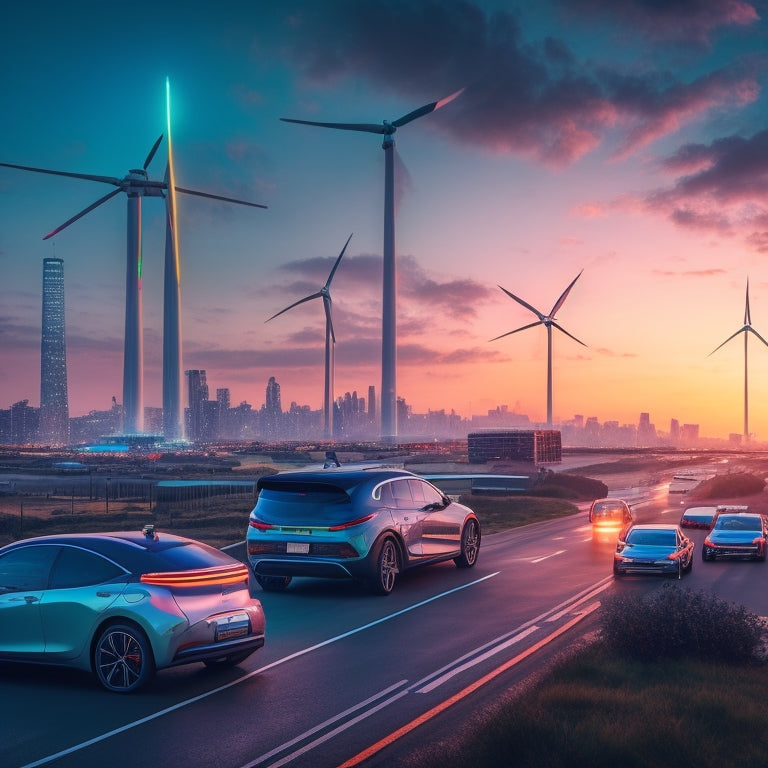
What Powers the Future of Fleet Electrification?
Share
As you initiate fleet electrification, you'll rely on a multifaceted approach that combines renewable energy sources, robust grid management, and scalable charging infrastructure. Harnessing solar power reduces emissions and energy costs, while wind energy provides an abundant resource. Effective grid management guarantees energy security, and optimized charging systems minimize strain on the grid. Scalable charging solutions meet growing demand, and energy storage systems guarantee uninterrupted operations. By integrating these components, you'll power the future of fleet electrification. Now, explore how these elements converge to shape the future of sustainable transportation.
Key Takeaways
• Renewable energy sources, like solar and wind power, reduce reliance on fossil fuels and lower carbon footprint.
• Smart grid technologies, including load management and peak shaving, optimize energy distribution and minimize strain on the grid.
• Scalable charging solutions and energy storage systems support the electrification of fleets, ensuring uninterrupted charging and operations.
• Effective grid management and peak demand management strategies reduce peak demand, preventing grid overload and energy waste.
• Incentives, such as tax credits and grants, and stable energy costs make fleet electrification a financially viable and environmentally friendly option.
Harnessing Solar Power for EVs
You can generate up to 30 kilowatt-hours (kWh) of electricity per day using a solar panel array, which can fully charge an electric vehicle (EV) like the Nissan Leaf in under 4 hours.
This means you can harness the power of the sun to fuel your EV, reducing your reliance on the grid and lowering your carbon footprint.
By installing solar panels, you can tap into the abundant energy resource that's available everywhere, converting sunlight into electrical energy through photovoltaic cells.
This energy harvesting technology allows you to generate clean, sustainable power, making it an attractive option for EV owners.
With the ability to generate up to 30 kWh per day, you can recharge your EV multiple times, making it an ideal solution for those with high-mileage needs.
Renewable Energy for Fleets
As you migrate your fleet to electric vehicles, you're likely considering how to power them with renewable energy.
You'll want to assess the solar power potential of your fleet's operating locations to determine the feasibility of on-site solar generation.
Additionally, you'll need to explore how wind energy can be harnessed to support grid resilience and guarantee a reliable supply of clean energy for your fleet.
Solar Power Potential
Solar power, a promising renewable energy source, can substantially reduce fleet emissions by harnessing the abundant energy from the sun to charge electric vehicles. As you explore the potential of solar power for your fleet, you'll discover various benefits that can help you achieve your sustainability goals.
Solar Incentives: Governments and organizations offer incentives to encourage the adoption of solar power, such as tax credits, grants, and rebates.
Carbon Credits: By harnessing solar power, you can reduce your carbon footprint and earn carbon credits, which can be traded or sold to offset emissions.
Predictable Energy Costs: Solar power provides a stable and predictable energy cost, shielding you from fluctuating fuel prices.
Scalability: Solar power can be scaled up or down depending on your fleet's energy needs, making it an adaptable solution for fleets of all sizes.
Wind Energy Harnessed
Wind energy, another abundant renewable resource, can be harnessed to substantially reduce your fleet's dependence on fossil fuels, complementing solar power in the pursuit of a sustainable energy mix.
By leveraging wind turbines, you can generate electricity and recharge your fleet's batteries, reducing greenhouse gas emissions and operating costs. This renewable energy source is particularly beneficial for fleets operating in regions with high wind velocities.
To optimize wind energy harvesting, you'll need to integrate energy storage solutions into your fleet's infrastructure.
This facilitates a stable and reliable power supply, even when wind speeds are low. Advanced energy storage systems can store excess energy generated by wind turbines during periods of high wind, releasing it when needed.
By combining wind energy with energy storage, you can create a resilient and sustainable energy ecosystem for your fleet.
As you shift to electric vehicles, incorporating wind energy into your energy mix can substantially reduce your carbon footprint and operating expenses.
Grid Resilience Matters
You must guarantee that your fleet's electrical infrastructure can handle the increased demand from electrification, which is where grid resilience comes into play. As you shift to electric vehicles, your energy requirements will skyrocket, putting pressure on the grid. To maintain a seamless fleet operation, you need to prioritize grid resilience.
Effective grid management is vital to maintaining energy security.
To ensure a smooth transition, you'll need to:
Grid capacity analysis: Assess your current energy infrastructure to determine its ability to support increased demand.
Peak demand management: Implement strategies to reduce peak demand, such as load shifting or peak shaving, to prevent grid overload.
Energy storage integration: Incorporate energy storage systems to stabilize the grid and provide backup power during outages.
Real-time monitoring: Implement advanced monitoring systems to track energy usage and grid performance in real-time, enabling data-driven decisions.
Advantages of Solar Charging
By leveraging photovoltaic technology, fleet operators can substantially reduce their reliance on fossil fuels, thereby minimizing their environmental footprint and operating costs.
You can harness the power of the sun to charge your fleet, reducing your dependence on the grid and mitigating the impact of price volatility. Solar arrays can be installed on-site, providing a clean and renewable source of energy.
This not only reduces your carbon emissions but also enhances your energy independence.
With solar charging, you can generate electricity on-site, reducing your reliance on the grid and avoiding transmission losses.
This decentralized approach to energy generation also improves your energy security, reducing the risk of power outages and disruptions.
Additionally, solar charging can provide a stable and predictable energy cost, shielding you from fluctuations in fuel prices.
Electric Vehicle Charging Infrastructure
As you consider electrifying your fleet, you'll need to assess the Electric Vehicle Charging Infrastructure, which is critical to supporting your shift.
You'll want to evaluate the availability of charging stations, ensuring they're conveniently located and accessible to your drivers.
Additionally, you'll need to examine the power grid's capacity to handle the increased demand and explore smart charging systems that optimize energy distribution.
Charging Station Availability
Electric vehicle (EV) adoption relies heavily on the widespread availability of charging stations, with a lack of accessible and convenient charging infrastructure hindering the shift to fleet electrification.
As you navigate the landscape of fleet electrification, you'll need to consider the importance of charging station availability. Without sufficient charging infrastructure, the adoption of EVs will be limited, and the benefits of electrification will remain out of reach.
To address this challenge, you'll need to prioritize the expansion of charging stations in strategic locations.
Station Expansion: Identify high-demand areas, such as urban centers and transportation corridors, and prioritize the installation of new charging stations.
Urban Planning: Collaborate with urban planners to integrate charging infrastructure into city design, ensuring convenient and accessible charging options for fleet operators.
Charging Speed: Install high-power charging stations that can quickly recharge EVs, reducing downtime and increasing fleet productivity.
Network Connectivity: Ensure seamless communication between charging stations, fleet operators, and EVs to optimize charging operations and minimize downtime.
Power Grid Capacity
You'll need to guarantee that the power grid can support the increased demand from EV charging, as a strained grid could hinder your fleet's ability to recharge efficiently.
As you shift to an electric fleet, you'll require substantial power upgrades to handle the additional load. This might involve upgrading your electrical infrastructure, including transformers, substations, and transmission lines, to facilitate reliable and efficient power distribution.
Grid expansion is vital to accommodate the growing demand for EV charging.
You'll need to assess your current grid capacity and identify areas that require enhancement. This might involve installing new power lines, upgrading existing ones, or incorporating smart grid technologies to optimize energy distribution.
Smart Charging Systems
Implementing smart charging systems allows your fleet operators to manage EV charging schedules and optimize power distribution, ensuring that your electric vehicles recharge efficiently and effectively.
This advanced technology enables you to streamline your fleet's energy consumption, reducing strain on the grid and minimizing costs.
Load management: Smart charging systems can detect periods of high energy demand and adjust charging schedules accordingly, preventing overload on the grid.
Peak shaving: By shifting non-essential charging to off-peak hours, you can reduce peak demand and lower your energy bills.
Optimized charging: Smart charging systems can prioritize charging for vehicles that need it most, ensuring that your fleet is always ready to roll.
Real-time monitoring: With real-time data and analytics, you can track energy consumption, identify areas for improvement, and optimize your charging strategy for maximum efficiency.
Grid Resiliency and EV Adoption
As the widespread adoption of electric vehicles (EVs) increases demand on the grid, utilities and policymakers must prioritize grid resiliency to facilitate a seamless integration of EV charging infrastructure.
You're likely aware that the influx of EVs will strain the grid, causing potential brownouts and blackouts. To mitigate this, grid modernization is vital. This involves upgrading infrastructure to accommodate the increased load, ensuring a stable and efficient supply of electricity.
Energy democracy, which empowers consumers to take an active role in energy management, is also key. You'll need to examine decentralized energy systems, where rooftop solar and energy storage enable households to generate and store their own energy.
This shift won't only support EV adoption but also create a more sustainable, community-driven energy ecosystem. By prioritizing grid resiliency and embracing energy democracy, you'll be well on your way to a seamless EV integration.
The future of fleet electrification depends on it.
Overcoming Range Anxiety
Range anxiety, a major psychological barrier to widespread EV adoption, stems from concerns about running out of charge before reaching a charging station, and addressing this fear is crucial by providing reliable and convenient charging infrastructure.
As you consider shifting your fleet to electric vehicles, you may wonder how to alleviate range anxiety for your drivers.
To overcome this hurdle, you can:
Educate drivers on EV range capabilities
Provide training on the actual range of your EVs, how to maximize it, and how to plan routes accordingly.
Implement anxiety mapping
Identify and map out high-anxiety areas where range anxiety is most likely to occur, and prioritize charging infrastructure development in those areas.
Invest in route optimization tools
Leverage technology to optimize routes, reducing the need for frequent recharging and alleviating driver concerns.
Develop a thorough charging strategy
Establish a network of convenient, reliable, and fast-charging stations, ensuring drivers can quickly recharge when needed.
Lowering Fleet Operating Costs
As you shift to an electric fleet, you'll notice significant reductions in operating costs.
You'll see fuel cost savings, thanks to electricity being generally cheaper than gasoline or diesel.
Additionally, you'll benefit from reduced maintenance needs and lower energy bills, further padding your bottom line.
Fuel Cost Savings
By switching to electric vehicles, you can substantially reduce fuel costs, which account for a substantial portion of your fleet's operating expenses.
This is because electric vehicles (EVs) have a remarkably higher fuel efficiency compared to traditional internal combustion engine vehicles. In fact, EVs can achieve an average fuel economy of 3 miles per kilowatt-hour, compared to 25 miles per gallon for gasoline-powered vehicles.
Lower fuel costs, increased fuel efficiency, reduced energy dependence, and a thorough cost analysis all contribute to the benefits of electric vehicles.
Lower Fuel Costs
Electric vehicles can reduce fuel costs by up to 70% compared to gasoline-powered vehicles.
Increased Fuel Efficiency
EVs convert about 60% to 70% of the electrical energy from the grid to power the wheels, while gasoline-powered vehicles only convert about 20% of the energy in gasoline to power the wheels.
Reduced Energy Dependence
By using electricity from the grid, EVs reduce dependence on fossil fuels, providing a more sustainable and environmentally friendly option.
Cost Analysis
A thorough cost analysis will reveal that the cost of electricity to charge an EV is substantially lower than the cost of gasoline, resulting in substantial savings over time.
Reduced Maintenance Needs
You can further reduce fleet operating costs by minimizing maintenance needs, which is another significant advantage of electric vehicles over traditional internal combustion engine vehicles.
Electric vehicles require less maintenance due to their simpler design, with fewer moving parts and no oil changes needed.
This reduced complexity leads to improved reliability, reducing downtime and increasing fleet productivity.
Additionally, electric vehicles have fewer components prone to wear and tear, extending their lifespan and reducing the need for frequent replacements.
This translates to lower maintenance costs, as you'll spend less on repairs, replacements, and labor.
With electric vehicles, you can also expect fewer brake pad replacements, as regenerative braking reduces wear on brake pads.
By switching to electric vehicles, you can enjoy significant cost savings and improved fleet efficiency, making your operations more sustainable and profitable.
Lower Energy Bills
Fleet electrification substantially reduces energy bills, as electric vehicles operate at a lower cost per mile compared to their gasoline-powered counterparts.
This reduction in energy expenditure is a significant advantage for fleet operators, as it directly translates to cost savings. By switching to electric vehicles, you can optimize your fleet's energy efficiency, resulting in lower energy bills and reduced operating costs.
Key benefits of fleet electrification regarding energy efficiency and cost savings include:
Lower Fuel Costs: Electric vehicles can save you up to 75% on fuel costs compared to gasoline-powered vehicles.
Reduced Energy Consumption: Electric vehicles convert about 60-70% of the electrical energy from the grid to power the wheels, while gasoline-powered vehicles only convert about 20% of the energy in gasoline to power the wheels.
Optimized Energy Use: Electric vehicles can optimize energy use by recovering energy through regenerative braking and using it to recharge the battery.
Predictable Energy Costs: With electric vehicles, you can better predict your energy costs, allowing for more accurate budgeting and financial planning.
Environmental Impact of EV Fleets
Electrifying your fleet can substantially reduce greenhouse gas emissions, air pollutants, and other negative environmental impacts associated with traditional internal combustion engine vehicles.
By switching to electric vehicles (EVs), you can markedly shrink your carbon footprint, contributing less to climate change and air pollution.
In fact, EVs produce zero tailpipe emissions, which means they don't emit pollutants that degrade air quality.
This is particularly important in urban areas, where poor air quality has severe health implications for residents.
Additionally, EVs can reduce well-to-wheel emissions by up to 70% compared to traditional vehicles.
This is because EVs can be powered by renewable energy sources like solar or wind power, further minimizing their environmental impact.
As you shift your fleet to EVs, you'll not only reduce your environmental footprint but also contribute to a cleaner, healthier environment for your customers and the community at large.
The Role of Energy Storage Systems
As electric vehicles increasingly dominate your fleet, the need for efficient energy storage systems becomes paramount to guarantee uninterrupted charging and operations. Energy storage systems play a vital role in supporting the electrification of your fleet, enabling that your vehicles are always ready to roll.
Higher energy density storage systems allow for more efficient use of space, reducing the overall footprint of your charging infrastructure.
Energy storage systems can help balance the grid by absorbing excess energy during off-peak hours and releasing it during peak demand periods, reducing strain on the grid.
As your fleet grows, your energy storage system should be able to scale to meet the increased demand, maintaining that your operations remain uninterrupted.
Seamless integration with your existing charging infrastructure is essential to guarantee that your energy storage system works in harmony with your fleet's unique needs.
Four key aspects are vital when implementing energy storage systems for your fleet:
Scalable Charging Solutions Needed
With your fleet's electrification pace quickening, you'll need scalable charging solutions that can keep up with the escalating demand for power.
As you prioritize your fleet's shift to electric vehicles, it's essential to think about the charging infrastructure that will support this change. Scalable charging solutions are imperative to minimize downtime and maximize productivity.
Fleet prioritization is key in determining the most effective charging strategies.
You'll need to assess your fleet's specific needs, taking into account factors like vehicle type, usage patterns, and route optimization. By doing so, you can optimize your charging infrastructure to meet the unique demands of your fleet.
Adherence to charging standards is also fundamental to facilitate interoperability and efficiency.
Standards like Combined Charging System (CCS) and Tesla's Supercharger enable fast and reliable charging, while also facilitating the integration of different charging networks. By adopting these standards, you can future-proof your charging infrastructure and guarantee seamless fleet operations.
Frequently Asked Questions
How Do Government Incentives Impact Fleet Electrification Adoption Rates?
You'll find that government incentives substantially boost fleet electrification adoption rates, as Tax Credit and extensive Incentive Packages offset costs, making electric vehicles a more viable option for fleet operators, ultimately driving growth.
Can Existing Infrastructure Support Widespread EV Charging Demands?
You'll need to assess whether existing infrastructure can support widespread EV charging demands by evaluating grid resilience and implementing load balancing strategies to prevent overloads and maintain a stable power supply.
What Is the Average Cost of Installing EV Charging Stations?
You'll face a cost analysis that reveals the average installation cost of EV charging stations ranges from $3,000 to $10,000, depending on the type and complexity, with installation challenges including electrical upgrades and permits.
How Does Weather Affect the Efficiency of Solar-Powered EV Charging?
You think solar-powered EV charging is a bright idea, but did you know that cloudy panels can reduce efficiency by up to 25%? Temperature coefficients also play a role, with high temps slashing output by 0.5% per degree Celsius.
Are There Standardized Charging Connectors for All Electric Vehicles?
You'll find that most electric vehicles use standardized charging connectors, adhering to universal standards like SAE J1772 and IEC 62196, ensuring seamless connectivity and efficient energy transfer, thanks to well-designed connector designs that prioritize interoperability.
Related Posts
-

3 Best Eco-Grants for Home Energy Upgrades
You're eligible for various eco-grants that can help you cut down on energy bills and reduce your carbon footprint by...
-

Why Vertical Gardens Reduce Home Energy Consumption
By incorporating a vertical garden into your home design, you'll reduce energy consumption through natural insulation...
-

Why Choose Solar Composting Toilets for Your Home?
By choosing a solar composting toilet for your home, you'll greatly reduce your environmental impact, slashing your w...


